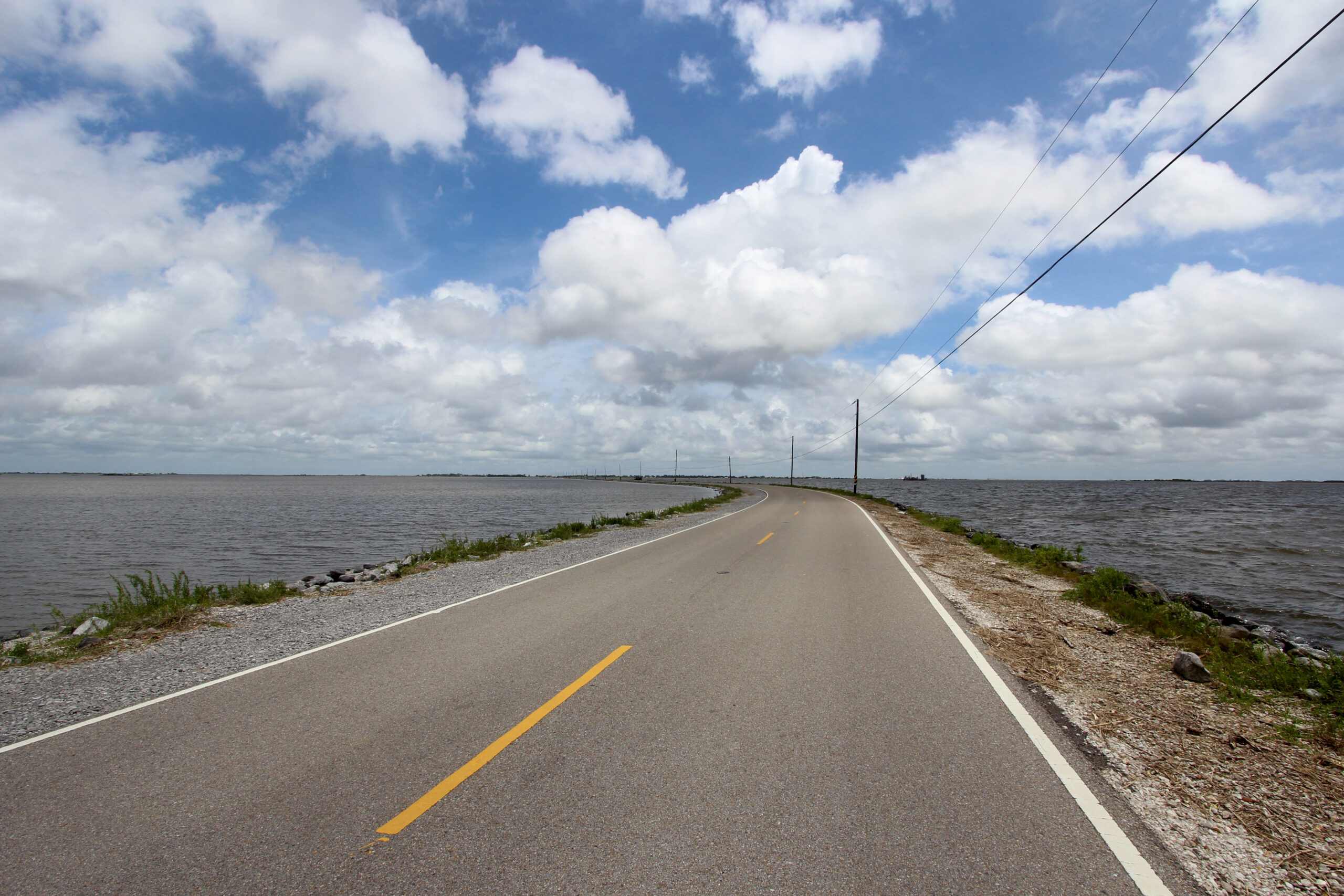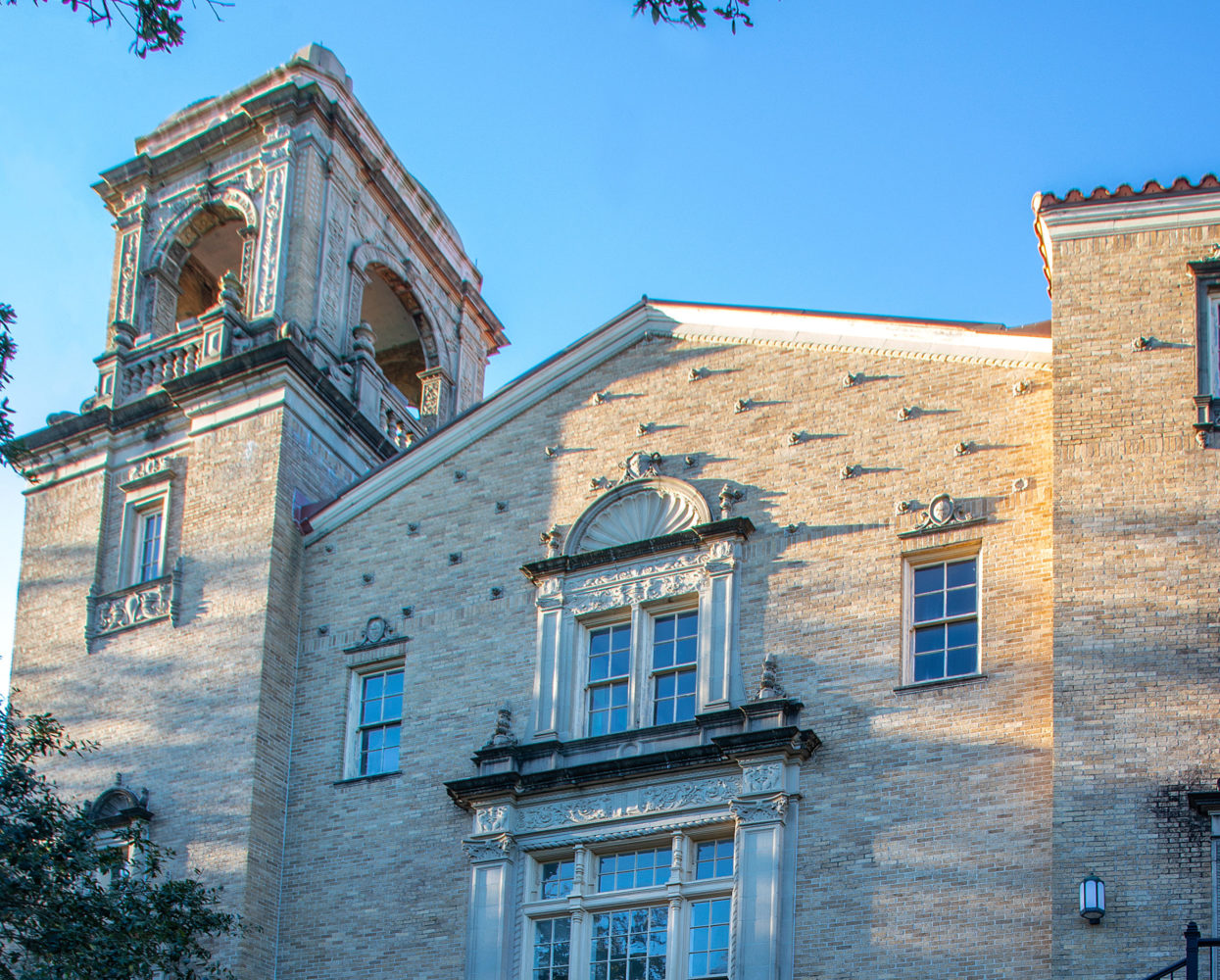Plans are in the works to relocate a Native American tribe that has been living on an island on Louisiana’s vanishing coast for over 200 years.
The island has lost almost 99 percent of its acreage to coastal erosion in the past 60 years.
The people of the island are facing a thorny preservation question: how do you keep an entire culture from washing away?
A dedicated group of state officials, planners, and tribal leaders are coming together to create a template for relocating communities endangered by rapidly shrinking coastlines.
View of the Water
Wenceslaus Billiot stands on his front porch on the Isle de Jean Charles in Terrebonne Parish.
Water laps at the base of a small levee 20 feet from the back door of his home, which sits perched on pilings 11 feet above a manicured lawn.
Between the house and levee, vegetables grow in small, well maintained strips of handmade garden planters, a testament to the self-sufficiency of the island’s residents.
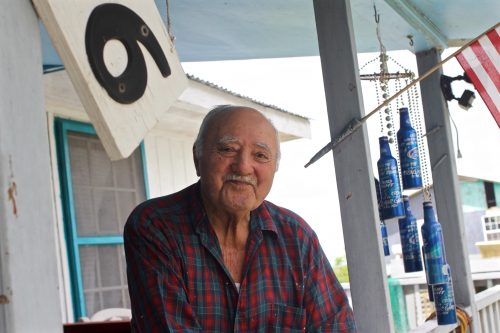
Photo by Liz Jurey
Handmade windchimes break up the silence as several American flags flap in the steady gulf breeze.
Across the island’s only road, another single file line of homes is backed by more open water, at once representative of the island’s primary means of sustenance and its steadily approaching destruction.
Billiot, an 89-year- old member of the Isle de Jean Charles Band of Biloxi-Chitimacha- Choctaw tribe, has lived on this sliver of land below Houma all his life.
Born just up Island Road from where he now lives, Billiot really only left the island to serve his country in the Army during World War II.
He saw action in the Pacific Theater before being sent to Germany during the occupation.
After the war, Billiot and his father built a trawling boat by hand, and they worked the water surrounding the Isle de Jean Charles for years, pulling in countless shrimp and oysters.
Life on the island was much different when Billiot was a young man, and fishing wasn’t the only way members of the tribe took advantage of the area’s abundance of natural resources.
“Way back in the old days, people used to trap, that used to be trapland!” Billiot said, pointing across the road to a patch of open water dotted with occasional clumps of marsh grass. “They trapped muskrat, and mink, raccoon, and whatever they had. Now it’s nothing but water.”
Louisiana is Losing Land
Only one road connects the island to the rest of Terrebonne Parish, and it has been reduced to two lanes snaking through open water on both sides.
A steady south wind will push water across the road, cutting off the island until the water subsides. A storm of any size means residents have to prepare for being cut off from the rest of the world for an indeterminate amount of time.
It wasn’t always that way.
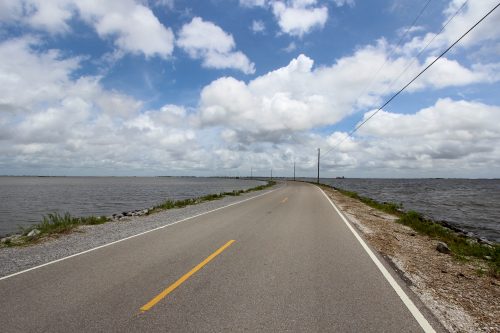
Photo by Liz Jurey
In 1955, the island was made up of 22,400 acres of land, which is about 18 times larger than City Park in New Orleans. Today, only 320 acres remain, an area about one quarter the size of City Park’s 1,300 acres.
“They had to build that road through the marsh,” Billiot said. “It was a good marsh. People used to walk on that marsh. It was hard land. They had some people from Bayou Lafourche that used to come trap on that marsh. Now it’s just water.”
The state of Louisiana is losing its coastline at an alarming rate, with estimates ranging from one football field’s worth of land every hour to nearly 30 square miles per year, according to the U.S. Geological Survey.
Few places demonstrate the devastating effects of this rapid land loss better than the Isle de Jean Charles.
Resettlement
Louisiana Office of Community Development executive director Pat Forbes said the amount of land loss surrounding the island puts it in the most dangerous tier of his office’s land rating system.
“The highest 100-year flood level is what we call Resettlement,” Forbes said. “Essentially, it doesn’t really make sense for us to invest in a place that is going to have a 14-foot or more 100-year flood level in the next 50 years.”
The 100-year flood model is based on the likelihood of a devastating flood occurring in a particular area. A 100-year flood refers to a flood that has a one percent chance of occurring any given year, while a 50-year storm has a two percent chance.
At this point, the odds of 14 feet of water essentially washing the Isle de Jean Charles off the map are far too high for comfort, especially once it became evident that the island would not fall within the protection of the “Morganza to the Gulf” levee system, Forbes said.
Having heard of the island’s precarious future even before Hurricanes Katrina and Rita, Forbes said he was on the lookout for ways to help the Biloxi-Chitimacha- Choctaw tribe relocate.
“When the National Disaster Resilience Competition came along, we reached out and talked to them right away,” he said.
The state of Louisiana ended up bringing home $92 million in grant money from the competition, which was administered by the United States Department of Housing and Urban Development.
HUD is using the program to direct $1 billion to cities, counties, and states that experienced presidentially-declared disasters between 2011 and 2013.
More than half of the grant money the state received, about $48 million, will be used to relocate the residents of Isle de Jean Charles to higher ground.
Giving Climate Change a Face
The voluntary relocation program aims to preserve the essence of the island’s unique community, which traces its roots back to the early 1800s when Frenchman Jean Marie Naquin moved to the island after being ostracized for marrying a local Native American woman named Pauline Verdin.
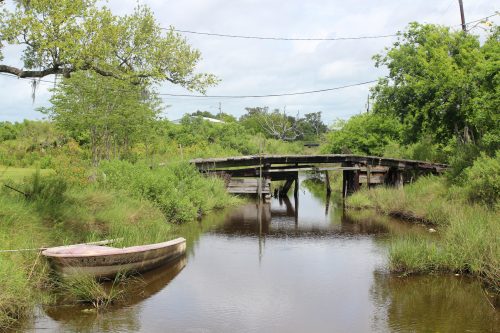
Photo by Liz Jurey
Two other mixed-race families soon joined, and the Isle de Jean Charles Band of Biloxi-Chitimacha-Choctaw tribe was soon established.
What was once a remote Cajun-inspired slice of paradise has been steadily whittled down by a confluence of ecological factors including saltwater intrusion, soil subsidence, hurricanes, and man-made disasters such as the BP Oil Spill.
With overwhelming scientific evidence detailing the effects of a steadily warming planet on areas susceptible to the effects of rising sea levels and changes to the surrounding ecosystem, it should come as no surprise that the fingerprints of climate change can be clearly seen on the Isle de Jean Charles.
Across the nation, Native American communities are increasingly finding themselves on the front lines of the climate change battle.
Tribes in Alaska and Washington state also applied for HUD’s NDRC grant, Forbes said.
“There are other places that are grappling with sea level rise and its impact to a way of life and to archaeological and cultural heritage resources,” NOLA Water Collaborative Coordinator Nathan Lott said. “Alaska is an example that is often cited where you have Native American villages or archaeological sites that are being eroded away because now the sea is not frozen as much of the year as it used to be, which has exacerbated the erosion along the coast.”
While the state’s official stance is to deal with the immediate impact and implications of land loss along the Louisiana coast without delving into the reasons behind the land loss, the issue is very clear-cut to those who have grown up watching their beloved island fall into the sea.
“In our mind, we have given climate change a face,” Tribal Executive Secretary Chantel Comardelle said. “This is reality. This is what climate change does to a community.”
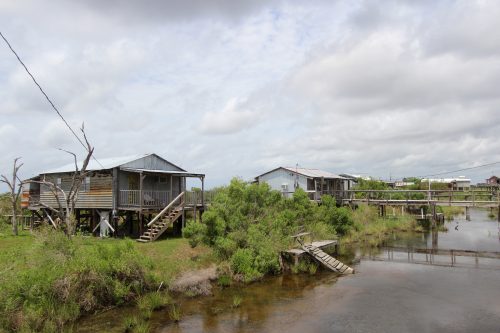
Photo by Liz Jurey
Losing the island doesn’t just hurt the approximately two dozen full time residents that still call the island home.
“This was our front lines of coastal defense for Houma,” Comardelle said. “Once you start letting these marshlands go, Houma becomes the front lines, and we’re seeing that now.”
Comardelle, who is Billiot’s granddaughter, lived on the island with her family until the age of four, when her father made the tough choice to relocate to higher ground after several hurricanes flooded the family’s home in quick succession.
In the past 16 years, Comardelle said she has watched the high water marks from floods during hurricanes push steadily further and further up the bayou, putting more and more residents at risk.
“The effects of just letting that one community go, it’s just a drop in the bucket,” she said.
But the problems don’t just begin and end with steadily increasing global temperatures as we see new historic high temperatures month after month.
“When you take climate change and look at it from our perspective, it’s layers of effects that all point back to one thing,” she said. “You have your man made disasters, like the BP Oil Spill -that’s a layer that has affected us. You have your natural disasters – your hurricanes – that’s another layer. There’s land loss from erosion and saltwater intrusion from gas and oil exploration. You have sea level rise and subsidence from the damming of the Mississippi River that robs us of sediment to rebuild the land. All those layers put together create the big ball of wax of climate change that we are dealing with every day.”
Every little bit has added up over the past generation to a looming permanent evacuation that the founders of the island community probably never envisioned as possible.
Transplanting the Community
Unlike “buy-out” programs that do little more than cut a check to cover relocation expenses, moving the tribe to higher ground is a very complex process designed to protect the essence of the island’s once-thriving community.
“This is definitely new ground,” Forbes said. “The basic model is buy-out, and the people scatter to the wind, and all the community that they had living in a tight knit little place like that is gone.”
While a wholesale community resettlement of this scale and detail could have been carried out before, Forbes said he hasn’t been able to find any examples.
“What HUD expects us to do is create a model for this community resettlement that is different from that model of just buying people out,” he said. “This is the first time that we know of that there’s been this government involvement in trying to make sure that we get the whole community moved. That’s important to HUD from a resilience standpoint, and this whole grant is built around resilience in the face of future disruptions and disasters.”
Joseph Evans and Barney Lighter of Evans + Lighter Landscape Architecture are working with the Lowland Center to work out the details of the tribe’s new home.
While a definite location has yet to be selected, Evans and Lighter have drawn up extensive plans that incorporate as many of the island’s current features as possible while strictly adhering to the gospel of sustainable living.
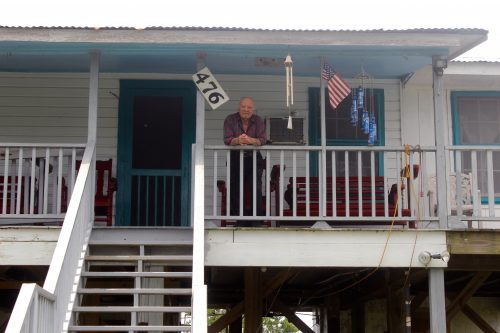
Photo by Liz Jurey
“In this design, we’re looking at sustainability and resilience in the long term,” Evans said. “We’re trying to design a safe and healthy site for the community so that they can re-engage with the culture and identity of the tribe.”
While many of the individual houses and structures are probably too weather beaten to relocate to the new site, a prospect complicated by the island’s extremely limited access to the mainland, aspects of the existing sites will live on in the new design.
“The idea is that the new building designs accept the vernacular of the camps, but they will be built to be more resilient,” Lighter said.
Each new house will face water, preserving the maritime views the island’s residents have come to expect.
The new site will also feature a single main road mimicking the way the current Island Road works its way down through the heart of what is left of the island.
Other influences on the planned new site will be more organic in nature.
Palmetto
“The palmetto is a very critical and historic plant to this community and to communities throughout this area,” Evans said. “Palmetto leaves were used as thatching for roofs on the homes, and it was also used for basketry. In a very real way, these palmetto leaves express community and tying people together.”
The basic shape of a palmetto leaf, a hub connecting long, thin branches splayed out in a fan-shaped pattern, became central to the new community’s outlay.
“We worked from that idea of a palmetto leaf as shelter and as a way to weave the community back together and bring their stories back together,” Evans said. “We approached it literally as a biomimetic motive for the rearranging of the town.”
A town center will be built in an area replicating the fan of the palmetto, with the homes radiating outwards.
But buildings and roads will not be the only things replicated at the new location.
“With whatever we have to work with, we want to introduce a forest that can regrow the indigenous canopy of the island,” Evans said. “We can reintroduce medicinal and edible plants that build on this deep tradition and ecological knowledge.”
Billiot laughs at the memory of stands of trees on the island as it was when he was a child.
Today, only a handful of trees remain, mostly aligned with the remaining houses.
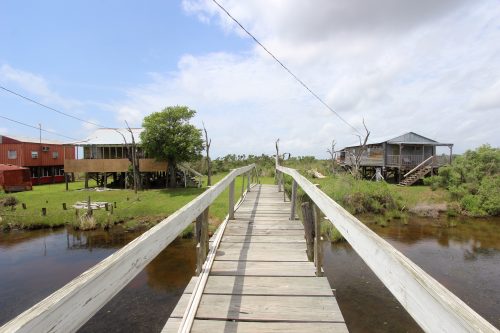
Photo by Liz Jurey
What was once a thriving ecosystem simply washed away over time.
With proper attention paid to utilizing water resources, Evans and Lighter envision a future where members of the tribe are able to revive traditions of farming, trapping, and hunting on their new land.
“We’re looking at integrating crawfish and wild rice,” Evans said. “All of these plans rely on aspects of agriculture, forestry, stormwater management, waste management, and energy production.”
Ain’t Got no Home
While Comardelle said most of the island’s residents are ready to move to higher ground, some are reluctant to abandon their homes.
“If some people want to leave, they can go, but leave us alone,” a handmade sign staked to solid ground near the front of the island reads. “The people have a right to live where they want, not where people tell them to go and live…God bless the island.”
For his part, Billiot said he plans to leave his home for higher ground without a fight.
“I tell you one thing: if a big hurricane comes, there won’t be no more road, probably,” he said.
“If I was a younger man, maybe I would stay, but not now. If the water moves us, we’re going to move.”




